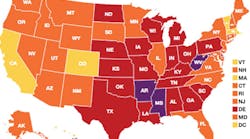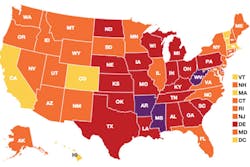Record the weight: The vital sign can help fight obesity in the dental setting
Weight is a vital sign, even in the dental setting
JoAnn R. Gurenlian
Figure 1: Adult obesity rate by state. Source: www.stateofobesity.org
This month's column focuses on a vital sign we tend to ignore that needs to have a light shining on it now more than ever. Some of our colleagues take blood pressure and pulse readings for their patients. Some even record temperatures, especially during this time of year, when patients are more likely to show up with respiratory infections or the flu.
What we often ignore is the weight of our patients-including young, middle-aged, and elderly. We just skip right over that item on the health questionnaire as if it has no consequence whatsoever. Yet weight is a huge (forgive the pun) risk factor for cardiovascular disease, stroke, type 2 diabetes, certain types of cancer, sleep apnea, and other illnesses.
According to recent National Health and Nutrition Examination Survey (NHANES) data, more than one-third of adults and 17% of children in the United States are obese, and this prevalence has remained high since 2003 (figure 1).1 In 2012, approximately one-third of children in the United States were overweight.2 Children and adults with weight-management issues are more likely to have low self-esteem and a negative body image.
As health-care providers and prevention specialists, we must recognize the obesity epidemic affecting both children and adults, and we must take action to address this public-health issue. While there are primary-care and pediatric interventions being tested, and while we are not registered dietitians or bariatricians, we can start taking steps to address this problem.
First, let's bring weight as a vital sign to the forefront: Take the measurement. That's right-get a scale. If you have just collapsed, breathe deeply and rethink these words. You cannot ask the patient for their weight. Why? Because people lie about their weight! Seriously, don't you? Of course, you shave off ten pounds or more when asked for your weight. You know you do. In the medical practice where I work part-time, men invariably add inches to their height, and women remove 10 to 20 pounds from their weight. Think about it this way: You wouldn't ask patients about pulse or blood pressure; you measure those. So buy a decent scale that is easy to read and that measures weight, body fat, and body mass index (BMI). If you are thinking that no one in dentistry does this, you are wrong. I have been in dental offices where measuring patients' weight is routine and patient acceptance is high. You are the one who needs to adjust to the idea, not the patient.
Next, link that weight measurement to health assessments, such as a glucometer reading, and to how the patient has been feeling-noting any joint pain, as well as difficulty sleeping, breathing, or exercising, etc. Pay attention to the health conditions the patient has listed on the health history form.
Another step is to share your findings with the patient's primary-care provider or pediatrician. We have the good fortune to see patients frequently, sometimes four or more times each year. We can track progress through electronic dental records and send a quick note to other health-care providers alerting them to changes in patients' weight (both losses and gains) that may be significant. This exchange of information provides an opportunity for collaboration and helps the patient see you as a champion of their health, supporting them in their effort to achieve wellness.
We all know that addressing weight can be challenging. Having another health-care professional offer regular support and encouragement can lead to a successful outcome. Weigh in on this one! RDH
References
1. Ogden CL, Carroll MD, Kit BK, Flegal KM. Prevalence of childhood and adult obesity in the United States, 2011-2012. JAMA. 2014;311(8):806-814.
2. Thompson AE. Childhood obesity. JAMA. 314(8):850.
3. The State of Obesity. Adult obesity rate by state, 2014. stateofobesity.org/adult-obesity. Updated September 21, 2015.
JOANN R. GURENLIAN, RDH, PhD, is president of Gurenlian & Associates, and provides consulting services and continuing education programs to health-care providers. She is a professor and dental hygiene graduate program director at Idaho State University, and president of the International Federation of Dental Hygienists.







